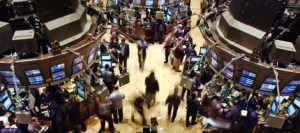
December 1, 2022 | Daily JAM |
At 2:20 p.m. New York time today, December 1, the Standard & Poor’s 500 traded at 4074. That’s just slightly above the 200-day moving average for the index of 4048. Yesterday, the S&P 500 closed at 4080. The 200-day-moving average was at 4050. Yep, once again, we’re seeing a struggle to break through technical resistance near the 4,000 level.

November 30, 2022 | Daily JAM, Videos |
Today I posted my two-hundred-and-eleventh YouTube video: The Fed Is Now On Message–Ask Why Today’s topic: The Fed is Now On Message, Ask Why. Last week I spoke about how confusing the Fed’s messaging had been recently, but this week, everybody has been on the same page. St. Louis Fed President, James Bullard, a fairly aggressive inflation fighter, suggested we need to take the Fed rate up to 5-7%, a hike from the current 3.75-4%. Loretta Mester, President of the Fed in Cleveland, agreed that the Fed isn’t near a pivot and John Williams, President of the New York Fed, came out with a detailed statement saying that more work is needed on inflation and unemployment may need to rise to 4.5-5% by the end of 2023. While Williams didn’t use the word, “recession,” it’s clear that you don’t reach those unemployment numbers without hitting a recession. So, why are these formerly out-of-sync Fed presidents suddenly aligned on message? The Fed is data-driven, and Fed members got new inflation and jobs numbers recently before the public release Thursday and Friday. Could be that these new data points have driven the Fed to the conclusion that we shouldn’t expect a pivot any time soon. Or maybe it’s just that the Fed goes into its quiet period soon before the December 14 meeting.

November 17, 2022 | Daily JAM |
Nothing unusual here. Major stock indexes such as the Standard & Poor’s 500 often struggle to take out 0000 landmarks. It’s common for an index to take several runs at such a landmark level before breaking through it. So it’s not surprising that since hitting 4025.26 intraday at 10:30 a.m. on Tuesday, November 15, the S&P 500 fell back at the close that day (to 3992.93), dropped again on November 16, and then closed down again on Thursday to 3946.56.
November 17, 2022 | Daily JAM, Morning Briefing |
The hits keep coming. Today, November 17, St. Louis Fed president James Bullard took the lead. Bullard called for raising rates to at least 5.00%-5.25%, which he called the “minimum level” to be “sufficiently restrictive.” During Bullard’s presentation, he showed charts indicating rates will need to be 5.00%-7.00% to curb inflation.

November 16, 2022 | Daily JAM, Videos |
Today I posted my two-hundred-and-sixth YouTube video. Today’s topic: 10% More to this Rally? The S&P rose above 4,000 Tuesday morning leading investors and analysts to forecast this rally climbing about 10% higher. Looking at a chart of the S&P 500 for a full year shows a clear bear market trend. Each high is lower than the previous high and the market has never seriously threatened to take out the December 2021 high. The current rally might be able to match the August peak of 4280 since investors are trying to take advantage of the rally before the year ends. But I don’t expect gains to stick. Looking forward, I still see high interest rates and a slowing economy and the Fed is unlikely to pivot away from its interest rate increases as investors hope. If you want to take advantage of the rally, by all means, go for it! Just remember, a 10% gain isn’t enough of a gain to justify betting the house.

November 16, 2022 | Daily JAM |
Is the Federal Reserve now in the business of talking down stock prices? It sure looked like it today.

November 11, 2022 | Daily JAM, Morning Briefing |
After Thursday’s CPI inflation report, stocks have a clear path to move higher in a strong rally through the end of the year. Critically, the October inflation report, which showed inflation falling slightly more than expected, gives Wall Street the data it needs to sustain its favorite rally story: Inflation has peaked and is heading down. Which means the Federal Reserve will soon pause its policy of increasing interest rates early in 2023 and pivot to cutting interest rates by the middle of the year. You could see that story at work in the huge jump in Treasury prices and the huge drop in yields. The yield on the 10-year Treasury fell 23 basis points to just 3.86% on Thursday That’s a huge move–and deeply significant–considering that the yield on the 10-yer bond was above 4%, at 4.21% on Monday, November 7.

October 28, 2022 | Daily JAM, Morning Briefing |
Bad earnings news from Alphabet (GOOG), Amazon (AMZN), Microsoft (MSFT), and (really bad news) Meta Platforms (META) this week, and yet, and yet stocks, even technology stocks are up strongly, very strongly, today. The Standard & Poor’s 500 finished the day ahead 2.46%. The Dow Jones Industrial Average was higher by 2.51%. The small-cap Russell 2000 gained 2.20%. And the technology=heavy NASDAQ Composite and the NASDAQ 100 added 32.87% and 3.17%, respectively. In the short run it can be extremely difficult to net out the forces pushes stocks higher and lower. Right now we have higher interest rates from the Federal Reserve, continued signs of a slowing economy, and slower earnings growth pushing stocks lower. Pushing stocks higher are hopes that the Fed will end its most aggressive interest rate increases soon, the speculative possibility that the U.S. economy might dodge a recession, and a flood of money in the hands of money managers who think they might be able to end the year on an up note because stocks have been punished enough in the short run.
At the moment, based on the market’s rally before tech earnings and the strong bounce today shaking off really negative earnings news from some of the market’s biggest stocks, I’d say that money talks. And that this rally looks set to continue, maybe even until the end of the year, simply because money managers are going to throw money at “bargain” stocks.

December 7, 2021 | AAPL, AMAT, ASML, Daily JAM, Morning Briefing, NVDA, NXPI |
Here we go again. It’s not that we really have any more information about the Omicron Variant–we certainly don’t know what its effects will be on global economic acuity–but just as fears that the Covid-19 variant would send the world back into lockdown crushed stocks last week, this morning, December 7, a belief that Omicron won’t be all that bad has taken root and stocks are soaring in morning action.

December 4, 2021 | Daily JAM, Mid Term |
Expect the the debate to go on. Are we seeing a top for this extraordinary rally? Are stocks headed to their first correction since dinosaurs walked the earth? (Actually stocks had their last 10% correction in February 2020 but almost nobody remembers because it didn’t last very long and soon stocks were on their way to infinity and beyond.) And will this correction be led by technology stocks, the stars of the last rally? Or is the huge and very quick drop in technology stocks and the smaller but still significant fall in a wider index such as the Standard and Poor’s 500 merely a rotation from one sector into another? For the record, as of the close on Friday, December 3, the S&P 500 was down 3.47% from its November 24 high. The NASDAQ Composite, with its heavier weighting in technology, was down 6.05% from its November 11 high.

November 19, 2021 | Daily JAM, Morning Briefing |
On November 15 in my post on what’s priced in and what’s not, I noted that an upsurge in Covid infections this winter wasn’t priced in. And that evidence of a new wave from Europe where infection rates have headed higher in what might be a preview for the winter in the United States could send stock prices lower. Well, yes indeedy. That exactly what happened today after the Austrian government announced a full lockdown starting on Monday, in response to surging cases of COVID-19. The lockdown will include both those vaccinated and unvaccinated, it will last for 10 days minimum, but could be extended for 10 days further. The fear is that Germany, which is battling its own higher rates of infection, is next.

November 13, 2021 | Daily JAM |
I expect the market reaction to Nvidia’s (NVDA) quarterly earnings report on Wednesday, November 17, to tell us a lot about market sentiment and the magnitude of any year-end, market melt up rally.












